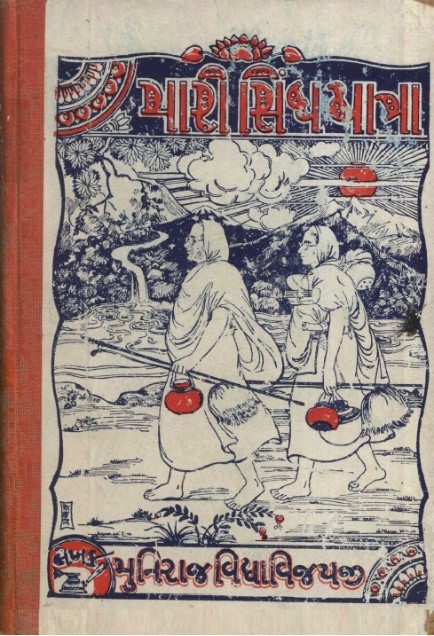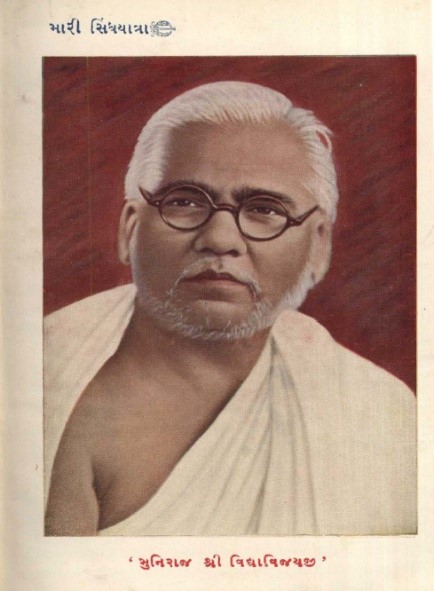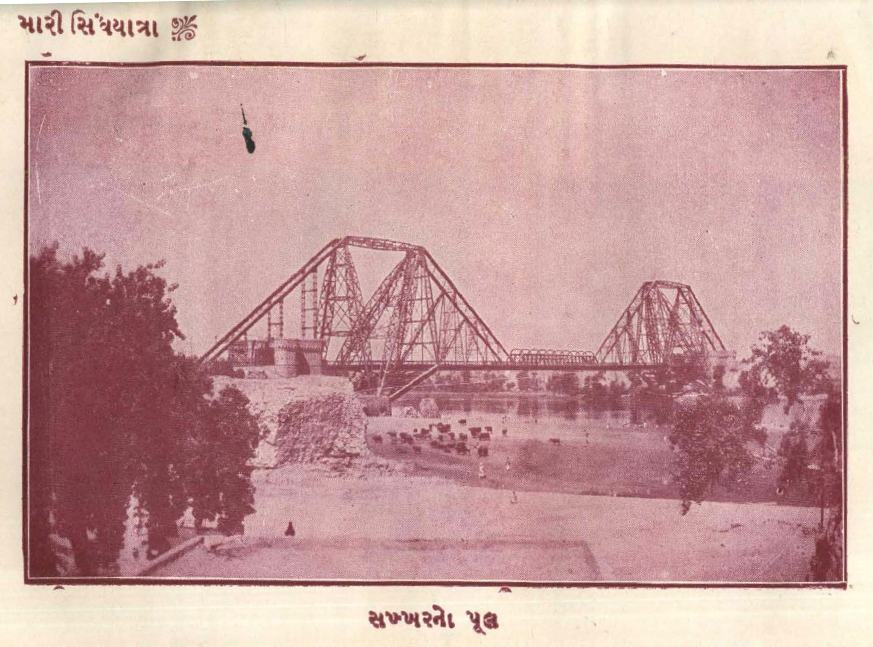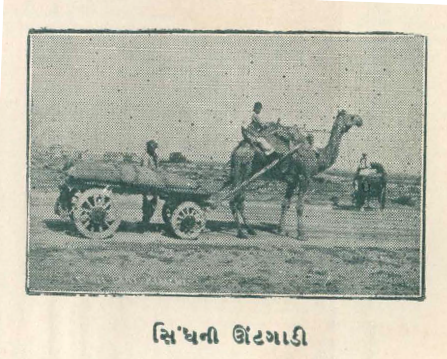
We have been hearing the incidents of robbery, atrocities, turmoil, and murders, but anyone having experience of Sindh can confirm that the unrest has been brought under control by the British government

[Editor’s Note: This is Part 02 (two) of a series of articles based on a pre-partition book named “મારી સિંધ યાત્રા” (“منهنجي سنڌ جو سفر”) in Gujarati authored by Jain Sadhu Shri Vidyavijayji, narrating his experiences of travel and stay in Karachi for about 2 and half a years between 1937 and 1939. It would be advisable to click on introductory article and read for better understanding of the series. – Nasir Aijaz, Editor Sindh Courier]
Vimal Shah, Mumbai
The British Period
“In 1809 Meers and British signed their very first treaty and they became allies for the very first time. But how long a friendship built on the foundation of self-interests would last? In 1843 AD Meer Nasir Khan and the British army confronted near Miyani. The commander from British side was Sir Charles Napier. The British army won in this battle. Meer Nasir Khan and other Meers laid down their weapons and surrendered to Napier. Sir Charles Napier hoisted the British flag on the Hyderabad fort on 18-02-1843. It is said that a renowned Hindu named Naumal Bhojwani had extended good help to the British government. In 1848 AD Sindh was annexed to the Bombay Presidency. Later in 1936 AD Sindh was declared as an independent province.”
The Transformation

“A person with this brief overview of the history of Sindh can easily imagine how this province would be in the past? Even until now, we have been hearing the incidents of robbery, atrocities, turmoil, and murders, but anyone having experience of Sindh can confirm that the unrest has been brought under control by the British government. Proper arrangements of army have been made. The masses started getting educated with native and English medium schools. The oppressors operating everywhere on their own will have begun to fear with the increase in the services like Telegram, Posts, Wireless and Radio. With the widening scope of local trade and through ports, people have started getting livelihood. Even religious atrocities have declined. Slowly the interest in literature has begun to rise. Water is abundantly available everywhere with the help of canals from the Sindhu River. Due to this farming is also rising. Municipalities have been established resulting in the benefits derived from local self-government. Dispensaries have been opened at many places. Thus, there has been a lot of transformation in the condition of Sindh with passing time.
The whole of Sindh has been divided into eight districts by the government – Karachi, Hyderabad, Tharparkar, Dadu, Nawabshah, Larkana, Sukkur and the North Frontier. Out of these, prime cities like Karachi, Hyderabad, etc. are worth seeing. There’s only one princely state in Sindh that is Khairpur.”
Ancient Places
“There are many ancient places that are of prime importance from archaeological perspective.
It has been revealed since many years that ruins of an ancient city are found on excavation at a place called Mohen-jo-Daro, about 25 miles from Bakrani station in the Larkana district. The design of the buildings and the houses found in the excavation is surprising. It is said that the planning of the drainage system is amazing. Jewels, earthen and metal pots, and many such relics have been found there. According to historians Aryans were habitats of this place in the early era.
Ever since the site at Mohen-jo-Dero has been excavated, a lot of interest has been generated amongst the archaeology enthusiasts. These inventions have proven the ancient civilization of Indian sub-continent to the world researchers. The real name of Mohen-jo-Daro in Sindhi is ‘Muhen-jo-Daro’ which means Mound of the Dead Men.
Dr. Bherumalji, a historian of Sindh has authored a book in English based on ‘Mohen-jo-Daro’. He has also translated Mohen-jo-Dero as Mound of the Dead Men. He has stated about its etymology that “A king named Daluray was lustful. He had propagated a rule that any girl marrying in the village must spend her first night with the king. He had a lust for his niece. He insisted that the rule must be applied for his niece as well. His sister was very deeply offended, became ireful and cursed the king. With the curse of his sister, his town plunged into the abyss. The name of the town was Brahmanabad. The name ‘Muhen-jo-Daro’ – Mohen-jo-Daro was derived from the mound of the dead bodies at this place.
Another ancient site ‘Sikka-jo-Daro’ is also situated in the Larkana district. Many ancient sikka (coins) are found at this place.
Third such site is ‘Kahu-jo-Daro’ found near Mirpurkhas. Buddha temples built by the second king Chandar of Brahmin dynasty are found at that site.
Apart from these – ancient relics are found and there are spectacular structures at Thatta, Sadhbela’s Mandir, and many more sites. Some places have natural hot water springs and other have hills of mountains. Some places have deserts and others having green lands cultivated with canal waters help cool the eyes.
Little away from Ranipur of Khairpur state there’s a small village named Daraz. There’s a makbara (Shrine) of Sachal fakir. The former mayor of Karachi, Mr. Hatim Alvi describes “This makbara is so magnificent that its sky high minars are visible from several miles. This makbara is in the middle of a dense forest and there are no visible signs of modern civilization in the surrounding hundreds of miles.”
“Who was Sachal fakir? Mr. Hatim Alvi has given his detailed introduction in his article published in the Deepavali issue of ‘Maha Gujarat’.”
 Sukkur Barrage
Sukkur Barrage
“The credit of transforming entire Sindh into green land goes to ‘Sukkur Barrage’. The ‘Sukkur Barrage’ dam on the Sindhu River is a spectacular structure. The length of this dam is 1 mile. It has 66 arches with gates of 60 feet width, 18 feet height, weighing 1400 maan [मण / ذهن].”
[Note by Vimal Shah: According to the “Ancient system” section of the “Indian Units of Measurements” page on Wikipedia at https://en.wikipedia.org/wiki/Indian_units_of_measurement
1 Maund (maan or man [मण]) = 4 Daseri = 8 Pasri = 40 Seer, where
1 Ser = 2 Adher = 4 Pav = 16 Chattank = 80 Tola = 933.1 grams
Therefore: 1 Maund (maan or man [मण]) = 40 X 933.1 grams = 37.324 kg
Therefore: 1400 Maund (maan or man [मण]) = 52,253.6 Kg = 52 tons (approximately)
According to the “Sukkur Barrage” page on Wikipedia at https://en.wikipedia.org/wiki/Sukkur_Barrage
“The retaining wall of the barrage has 66 spans (outfall gates), each 18 meters (60 ft) wide and weighing 50 tons.”
Both the figures are very close.]
“Water flows to difference branches of canals through these gates. The gates are so heavy that electrical equipment is required to operate them. The cost of construction of ‘Sukkur Barrage’ is estimated at Rs.20 crores”.
What do the scholars say?
“Sindh has a distinguished status in the history of the Indian sub-continent. Some writers consider desert (sands), camels and donkeys as the main factor in the popularity of Sindh. In the praise of Sindh, the famous poet Nhanalal of Gujarat says:”
“Vines in Shakuntala’s jungle are abundant than the vines of city gardens, likewise your deserts are abundant than anything else in your country. Your deserts provide Sanjivani to your country. Your deserts are like sprinkling nectar on the visitors.”
[Note by Vimal Shah: The essence of any poetic composition is best understood only in the native language. I am not satisfied with this translation but that’s the best I could do. ‘Sanjeevani’ is a divine herb which can infuse life even in dead body.]
“Highlighting the importance of the three most popular objects of Sindh – deserts, camels, and donkeys – with appreciative perspective, scholar and author Jaduray D. Khandhadiya says:”
Camels have played prime role in many tales full of intense love and bravery. She camels with speeds exceeding winds have created vivid chapters in the history
 “Edison has invented valuable sound from sands only and infused in the invention of phonograph. Sand has gemstones too, only those who discover can obtain them. Camels and donkeys are also not to be considered worthless. Camels have played prime role in many tales full of intense love and bravery. She camels with speeds exceeding winds have created vivid chapters in the history. And the donkeys and their poor owners play an important role in the development of Sindh by carrying loads of goods from place to place.”
“Edison has invented valuable sound from sands only and infused in the invention of phonograph. Sand has gemstones too, only those who discover can obtain them. Camels and donkeys are also not to be considered worthless. Camels have played prime role in many tales full of intense love and bravery. She camels with speeds exceeding winds have created vivid chapters in the history. And the donkeys and their poor owners play an important role in the development of Sindh by carrying loads of goods from place to place.”
“And in the pride saga of Sindh, he further says:”
“Sindh is the original abode of the Aryans. There’s a fiery history of Sindh. Adjoining Punjab and Afghanistan, that territory is making a history now.”
“Thus, Sindh holds a significant position from historical as well as literary perspective. There are plenty of aspects of Sindh that are worth mentioning; but I conclude here since my objective here is limited only to give a brief introduction of Sindh.” (Continues)
__________________
About the contributor of the series of Articles based on the book
 Vimal Shah is a follower of Jainism by birth and is based in Mumbai, India. He is a Computer Engineer and holds a Diploma in Jainology from Mumbai University. He has immense interest in reading, writing, studying, and teaching Jain Philosophical subjects. He conducts classroom as well as on-line sessions on Jain Philosophical courses. He has created several power point presentations with animation which he uses while teaching and has participated in several Jain Community events to present and explain the relevant subjects to the visiting audience. He has significantly contributed to the translation, reviewing, and editing of the set of books ‘Compendium of Jainism’ of JAINA, USA from English to Gujarati – an initiative of the JAINA India Foundation. He is also associated with a Project for the translation of Jain Aagams (Scriptures) from Gujarati to English and continues to study various subjects and remains a student of Jain Philosophy. He has a special interest in the history and preservation of the Jain Heritage in Pakistan, and is associated with the Jain Heritage Foundation, New Delhi.
Vimal Shah is a follower of Jainism by birth and is based in Mumbai, India. He is a Computer Engineer and holds a Diploma in Jainology from Mumbai University. He has immense interest in reading, writing, studying, and teaching Jain Philosophical subjects. He conducts classroom as well as on-line sessions on Jain Philosophical courses. He has created several power point presentations with animation which he uses while teaching and has participated in several Jain Community events to present and explain the relevant subjects to the visiting audience. He has significantly contributed to the translation, reviewing, and editing of the set of books ‘Compendium of Jainism’ of JAINA, USA from English to Gujarati – an initiative of the JAINA India Foundation. He is also associated with a Project for the translation of Jain Aagams (Scriptures) from Gujarati to English and continues to study various subjects and remains a student of Jain Philosophy. He has a special interest in the history and preservation of the Jain Heritage in Pakistan, and is associated with the Jain Heritage Foundation, New Delhi.
Click here for Part-I